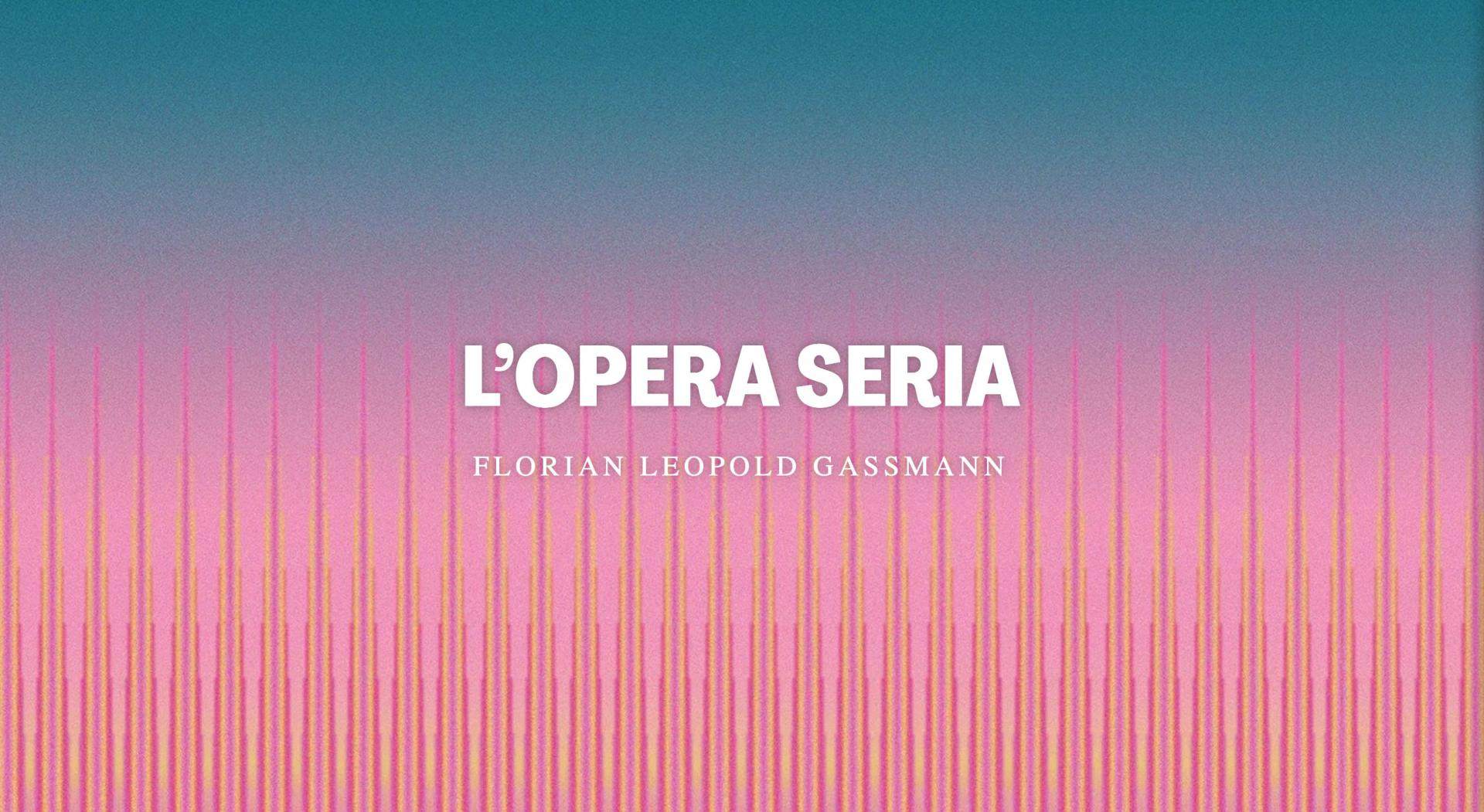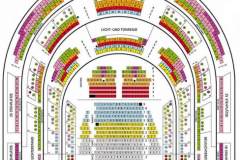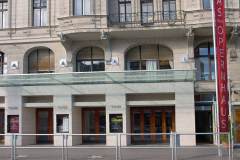L’opera seria
Mo | Tu | We | Th | Fr | Sa | Su |
In Italian with German and English surtitles
Introduction to the work 30 minutes before curtain-up
Commedia per musica in three acts
Libretto by Ranieri de’ Calzabigi
The composer Sospiro and the author Delirio are getting ready to proudly present their new opera. But now the problems start: the impresario Fallito wants to make cuts, the prima donna Stonatrilla wants more attention, another of the singers wants a new aria and the two castrato singers fail to appear at all. And to top it all, the singers’ mothers are interfering with everything. Despite all this, the opera Oranzebe is eventually performed – and ends in comical chaos. With L’opera seria, the composer Florian Leopold Gassmann and his librettist Ranieri de’ Calzabigi created one of the most madcap opera parodies of the 18th century. The work, first performed in 1769 at the Burgtheater, celebrates the wit and artful characterisation of opera buffa by ridiculing the worst sins of serious opera with arrogant singers, pointless virtuosity, overblown sets and costumes, and insincere pathos. Not for nothing was librettist Ranieri de’ Calzabigi the driving force behind Christoph Willibald Gluck’s operatic reform, while Florian Leopold Gassmann, in his capacity as director of music at the court of Joseph II, acted as the link between Gluck and the generation of the First Viennese School. Director Laurent Pelly, who masterfully combines biting satire and comedy in his productions, brings L’opera seria back to the city it was first performed in. Christophe Rousset, a regular guest at the MusikTheater an der Wien as a specialist in 18th-century music, conducts his ensemble, Les Talens Lyriques.
Co-production with the Teatro alla Scala, Milan
Synopsis
In a theater, final rehearsals are underway for the opera seria L’Oranzebe, which is set to premiere that very evening. Present are the impresario Fallito, the librettist Delirio, and the composer Sospiro, who is also conducting the piece and still making changes.
In Act I, the singers arrive.
Act II covers the rehearsal.
In Act III, the premiere of L’Oranzebe is staged—and it ends in a spectacular failure.
Act I
Room with table and chairs in the impresario’s house
Scene 1:
After completing their opera, librettist Delirio and composer Sospiro praise each other’s work (Duet: "Oh che bell’ Opera"). Impresario Fallito, however, demands cuts (Aria Fallito: "Signor Delirio tante sentenze"). The two artists quickly drop their fake compliments and argue.
Scene 2:
A servant calls Delirio away; the singer Ritornello wants to speak to him privately. Sospiro and Delirio complain about Fallito's arrogance (Duet: "Hò di fuoco nel petto un Vesuvio").
Scene 3:
Soprano Stonatrilla is offended that no one welcomed her (Aria: "Camerieri, Staffieri, Lacchè!"). Fallito apologizes, saying everyone is busy rehearsing. She insists her artistic stature deserves special attention.
Scene 4:
Sospiro and Porporina, a mezzo specializing in trouser roles, arrive. A catfight breaks out between her and Stonatrilla, mocking each other's age and inexperience (Aria Stonatrilla: "Ragazzuccia mettete giudizio"). Stonatrilla exits.
Scene 5:
Fallito asks Porporina to calm down. She reminds Sospiro of a promised aria. He has it ready and sings it to her (Aria Sospiro: "Cari quegli occhi amabili").
Scene 6:
Porporina plans to keep the infatuated composer close for future benefits. The hypersensitive second soprano Smorfiosa enters, immediately complaining.
Scene 7:
Ritornello enters singing a love song (Aria: "Benchè da te lontano"). After being noticed, he promises to support Smorfiosa on stage. Porporina teases the couple before leaving (Aria Porporina: "Più non si trovano frà noi le mutrie").
Scene 8:
Ritornello and Smorfiosa declare their love (Aria Smorfiosa: "Mio dolce amorino").
Entrance Hall in Fallito’s House
Scene 9:
Ballet composer Passagallo advises Fallito to hire two passing dance couples (Aria: "Vederete che salti, che slanciano").
Scene 10:
Fallito complains about the struggles of running a theater. Delirio and Stonatrilla offer advice. Delirio claims success is guaranteed—if sets, libretto, and singing are solid—but music? Not so much (Aria Delirio: "State attento a quest’ Oracolo").
Scene 11:
The others enter to inspect the dancers Passagallo brought. Then they examine their costumes and printed libretti, but no one is pleased (Ensemble: "Io vi giuro mie Dive adorabli"). The act ends in chaos.
Act II
Gallery with harpsichord and chairs in the impresario’s house
Scene 1:
Delirio and Sospiro appear to have reconciled. Fallito tells them Ritornello wants his aria changed—he dislikes the rhythm. This sparks another quarrel (Trio: "Asinaccio! Ignorantacci!").
Scene 2:
Fallito tries to fix the mess and asks Delirio to revise the aria—Delirio already has. Fallito thanks him with fatherly advice: never become an impresario (Aria: "Se di fare l’impresario").
Scene 3:
Delirio takes the advice seriously. Ritornello arrives but can barely read the revised text (Duet: "Quel Cocchier – Nò, nò: Nocchiero").
Scene 4:
Sospiro suggests the new text fits an older, successful aria Ritornello knows well (Aria: "Col tuo dolce amico oblio"). Sospiro sends it to the copyist.
Scene 5:
Sospiro wrote a new aria for Porporina, tailored to her strengths (Aria: "Barbara! E non rammenti"). She likes it.
Scene 6:
Everyone arrives for rehearsal. Since singers Gargana and Gastigo are absent, they skip to Act III. Smorfiosa asks to omit recitatives; Sospiro agrees.
Ritornello’s number ("Abbastanza finora") is criticized. Smorfiosa’s aria ("Va: sul tuo cap, ingrato" / "No crudel d’amor capace") pleases Ritornello but Delirio finds the music mismatched.
Stonatrilla and Ritornello’s duet ("Ah non mi dir così") bores everyone. Porporina’s metaphor aria about dolphins and tuna ("Già propizio à miei voti") is unintentionally comical.
Stonatrilla rehearses her dramatic suicide scene ("Dove son! Che m’arriva!" / "Pallid’ ombra del misero amante"). Ritornello introduces a new aria ("Quel Nocchier, che scioglie a’ venti") but altered the text—Delirio finds the music unsuitable.
During the ballet rehearsal, singers mock the dancers. The fight escalates until Fallito calls the guards to restore order (Ensemble: "Conoscete eh Porporina?"). He considers jailing everyone.
Act III
A large square in Agra, Mughal Empire's capital, decorated with arches and trophies celebrating Nasercano's victory
Scene 1:
Mughal general Nasercano (Ritornello) enters triumphantly. His spoils include Indian Queen Saebe (Smorfiosa). He praises his soldiers but doesn’t want their glory to outshine his (Aria: "Se con voi dò in braccio al vento"). Saebe laments her treatment by Emperor Oranzebe, asking Nasercano for mercy or death. Only love softens her chains (Aria: "Saprei costante, e ardita"). Nasercano assures her Oranzebe plans to crown her queen.
Scene 2:
Officer Rana (Porporina) praises Nasercano on behalf of India's heroes.
Scene 3:
Princess Rossanara (Stonatrilla), Oranzebe’s sister and Nasercano’s fiancée, is carried in on a decorated litter. Attendants fan her. She thanks Nasercano but becomes jealous when he’s reminded of Saebe (Aria: "Nò; se a te non toglie il Fato").
Scene 4:
Loud booing and disruptions from the audience halt the performance. The cast flees. Passagallo is especially upset—his ballets will now go unseen (Aria: "I miei Balli son tanti miracoli").
Program and cast
Conductor: Christophe Rousset
Director and Costume Design: Laurent Pelly
Stage Design: Massimo Troncanetti
Light Design: Marco Giusti
Choreography: Lionel Hoche
Dramaturgy: Kai Weßler
Fallito: Pietro Spagnoli
Delirio: Mattia Olivieri
Sospiro: Petr Nekoranec
Ritornello: Josh Lovell
Stonatrilla: Julie Fuchs
Smorfiosa: Andrea Carroll
Porporina: Serena Gamberoni
Passagallo: Alessio Arduini
Bragherona: Alberto Allegrezza
Befana: Nicholas Tamagna
Caverna: Filippo Mineccia
Les Talens Lyriques
Theater an der Wien
About the Theater an der Wien
The New Opera House is not just any theatre, but the one that Emanuel Schikaneder, the all-round genius, actor, impresario with a flair for organization but above all librettist of The Magic Flute, had built in 1801 in Vienna in keeping with the spirit of Mozart.
To coincide with the 250th anniversary of Mozart’s birth the Theater an der Wien presents itself as a new opera house from January 2006. As a “season” opera house with productions all the year round the Theater an der Wien carves a new and independent niche in the realm of high-quality culture in Vienna. For twelve months of the year, with one premiere every month, opera will be performed under the “stagione”, or season, system: that means the cast remains unchanged from the first performance to the last one, which guarantees that the very highest international standards are maintained.
The theatre’s modern, accessible approach to music theatre as demonstrated by the works performed, the overall artistic concept Bespielung and the artistes is further underlined by the building itself, its architecture and the vibrancy of its location. The surroundings and materials, the intimate atmosphere and perfect acoustics in the historical theatre prepare the senses to experience beauty. The Theater an der Wien deliberately enters into a symbiotic relationship with its lively surroundings on the Naschmarkt street market and the young cultural scene centred in the Schleifmühl quarter.
How to get there
With public transport:
We can be reached by public transport:
U1, U2 und U4 Station Karlsplatz, Exit Secession
Bus 59A Station Bärenmühldurchgang
Bus 57A Station Laimgrubengasse, pedestrians via Laimgrubengasse to Linke Wienzeile
KAMMEROPER:
Fleischmarkt 24, 1010 Wien
We can be reached by public transport:
U1, U4: Station Schwedenplatz
Tram Linie D (bei Ablenukung über Kai), 1, 2: Station Schwedenplatz
Bus 3A (on workdays)

 EN
EN DE
DE IT
IT FR
FR ES
ES RU
RU JP
JP RO
RO
 Seating plan
Seating plan 